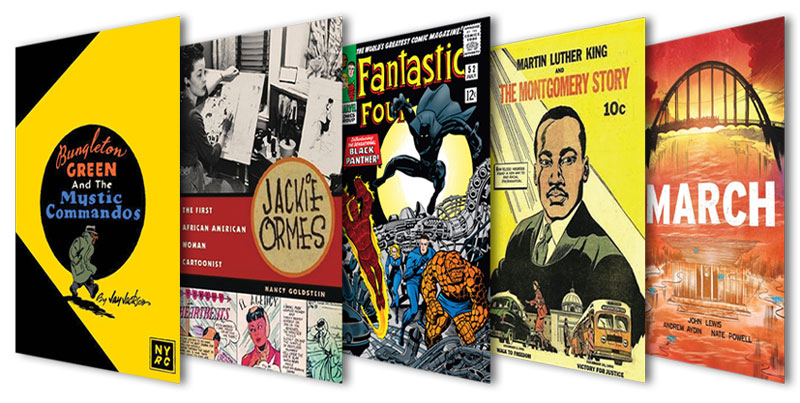Black Comics Pioneers
Creators of breakthrough works and characters, from Bungleton Green and Torchy Brown to the Black Panther superhero.

Related reading: |
In the early 1900s, when comic strips became a mass medium, Black cartoonists flourished in Black-owned newspapers. There were 2,700 of these papers in the United States in 1900, and by the middle of the decade, many carried their own strips. Perhaps the best known of these was Bungleton Green, started by Leslie Malcolm Rogers in the Chicago Defender in 1920. What began as a slice-of-life gag strip shifted to a soap opera–style serial in 1929, when creator Henry Brown took over, and then to a sci-fi/superhero strip after Jay Jackson became the writer and artist in 1934. The strip ran in this and various other guises until 1964.
Jackie Ormes, the first Black woman cartoonist to have a nationally distributed comic strip, also found a path to publication in the Black press. She made her mark with Torchy Brown, which debuted in the Pittsburgh Courier. Torchy published off and on until 1954, often taking on social and political issues in its storyline.
In 1944, Jerry Iger hired Matt Baker to the previously all-white Iger Studios, which produced comics for numerous publishers. Baker created what is thought to be the first Black superhero, Voodah.
The next Black superhero, Lion Man, debuted in All-Negro Comics #1 in 1947. The comic was edited by Orrin C. Evans, a journalist who wanted to showcase work by Black creators, entertain Black readers, and counter racist depictions in mass media. The comic was well received and got a favorable review from First Lady Eleanor Roosevelt. But a second issue was never published, reportedly because racist vendors refused to supply Evans with paper.
A 1957 comic played a key part in the civil rights movement: Martin Luther King and the Montgomery Story told of the Montgomery bus boycott and outlined the basic principles of nonviolent protest. The comic was produced by the studio of Li’l Abner creator Al Capp and distributed by churches, schools, and activists, though there were attempts to suppress it in the South. Over 50 years later, Rep. John Lewis cited it as an inspiration for his graphic memoir, “March.”
In the early 1960s, some newspapers would still cancel a strip if it introduced a Black character, but in 1965, cartoonist Morrie Turner prevailed with Wee Pals, the first nationally syndicated strip with a multiracial cast. In 1968, Turner’s friend Charles Schulz introduced Franklin, the first Black Peanuts character. For years, Franklin stood alone, while Turner kept adding characters to what he called his “Rainbow Kids.”
The Black Panther superhero stepped out in 1966 in Fantastic Four #52. Created by Stan Lee and Jack Kirby, two white men concerned about the lack of Black characters in their work, Black Panther appeared in various Marvel comics before getting his own series in 1977.
In 1993, four Black creators, Dwayne McDuffie, Denys Cowan, Michael Davis, and Derek T. Dingle, formed Milestone Media, which published several series distributed through DC. Milestone closed in 1997, but DC had acquired the rights and brought the line back in 2021, and now publishes new comics and new editions of older stories.
Since the rise of graphic novels in the 2000s, Black creators have established several milestones: In 2016, the third volume of Lewis’s memoir, “March,” was the first graphic novel to win a National Book Award, and in 2020, Jerry Craft’s New Kid won the Newbery Award, another first for the medium. In the superhero realm, the popularity of the 2018 film Black Panther spurred renewed interest in Black superheroes, including Shuri, Storm, and Miles Morales at Marvel and, on the DC side, Nubia and the Milestone characters.
Brigid Alverson edits “Good Comics for Kids.”
RELATED
The job outlook in 2030: Librarians will be in demand
The job outlook in 2030: Librarians will be in demand
ALREADY A SUBSCRIBER? LOG IN
We are currently offering this content for free. Sign up now to activate your personal profile, where you can save articles for future viewing





Add Comment :-
Be the first reader to comment.
Comment Policy:
Comment should not be empty !!!